How to Replace Continuous Corner Gutter
1 / 14
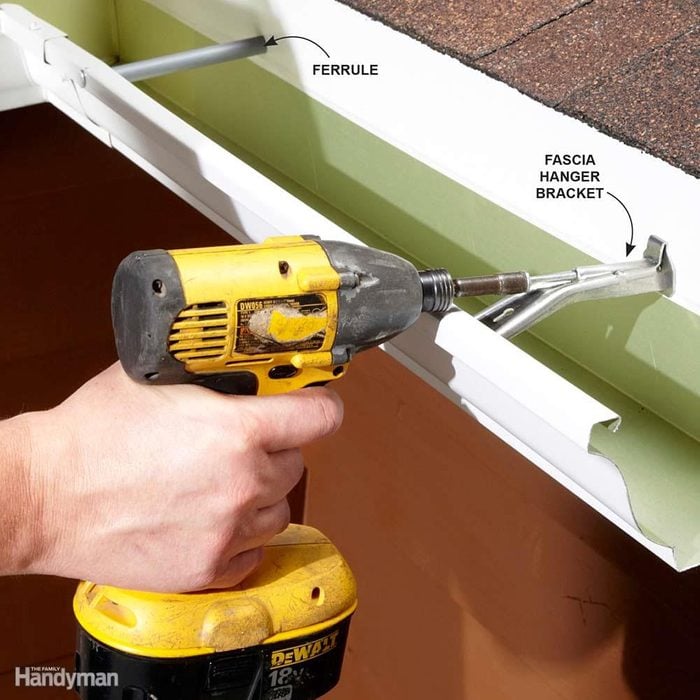
Loose Gutters
Years ago, spikes and ferrules were a common method for hanging gutters. They do the job all right, but eventually the spikes work themselves loose. Pounding them back in is a temporary fix at best. One way to make sure your gutter doesn't fall off the house is to install fascia hanger brackets. Installation is simple: Just hook the bracket under the front lip of the gutter, and then screw the other side of the bracket to the fascia. Leave the old spikes in place—a spike head looks better than a hole in the gutter. If your shingles overhang your fascia by a few inches or you have steel roofing, buy the brackets with the screws built in (the type shown here). They cost more, but the head of the screw remains a couple of inches away from the fascia, making them a lot easier to install.
2 / 14
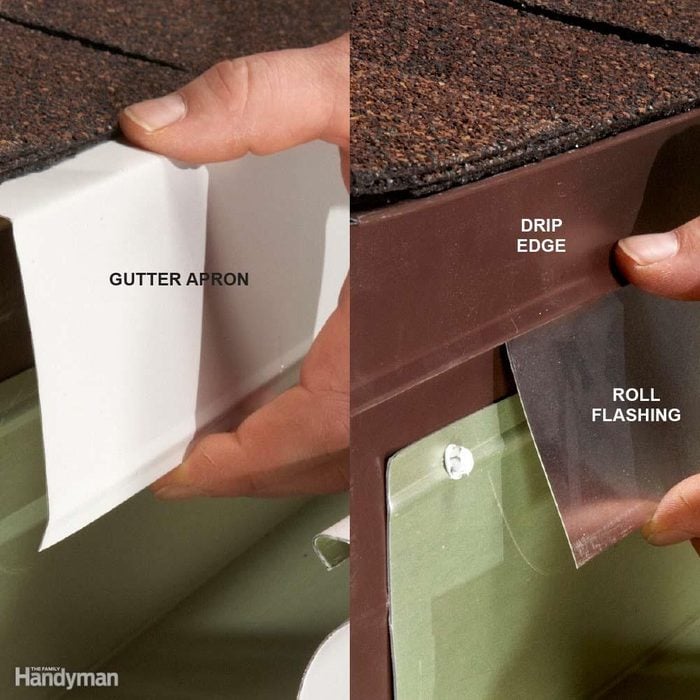
Water Gets Behind the Gutter
If water is dripping behind your gutter, it's probably because it was installed without any flashing over the back of the gutter. The gutter apron will prevent the dripping. A gutter apron is a bent piece of flashing that tucks up under the shingles and over the gutter. Home centers sell a gutter apron in 10-ft. sections. You may have to temporarily remove your hangers as you go, or you can notch out the apron around them. Once the apron's in place, fasten it with sheet metal screws. If there's a drip edge installed where the fascia meets your shingles and the gutter is hung below the drip edge, get some roll flashing and tuck it up under the drip edge and over the top of the gutter. Home centers sell rolls of 6-in. x 10-ft. aluminum flashing. Use tin snips to cut the gutter apron flashing roll in two 3-in. strips. If your gutters are steel, buy steel roll flashing, because galvanized steel corrodes aluminum.
3 / 14
Watch this video to learn more about DIY gutter repairs and gutter guards for your home:
4 / 14
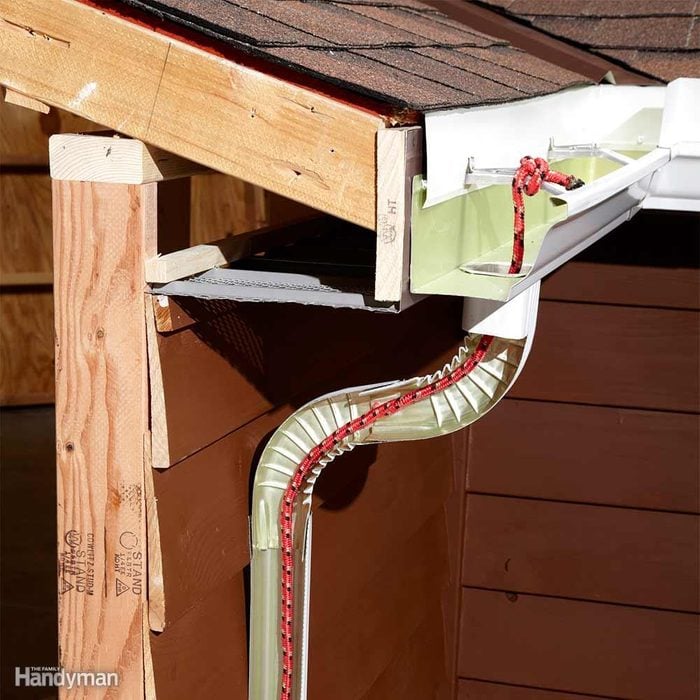
Annoying Drips
Is the sound of dripping in your downspouts driving you mad? Eliminate the problem by tying a rope onto one of the gutter hangers and running it down into the downspout. Drops of water will cling to the rope instead of plummeting the whole length of the downspout and causing that loud dripping noise.
Adding a rope does restrict water flow, so this may not be the best option if your gutter is prone to overflowing or if your downspout is easily clogged with twigs and leaves. Buy a rope made of a synthetic like nylon—a rope made from natural fibers will rot away.
Read more.
5 / 14
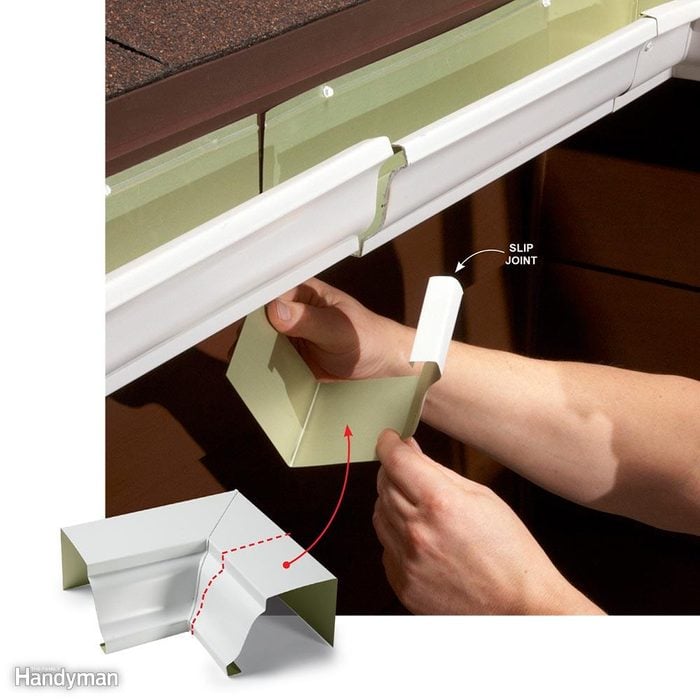
Make Repairs With a Slip Joint
If a tree branch falls on the last 4 ft. of your 60-ft. seamless gutter, you don't need to replace the whole thing; just replace the damaged section. If your gutters are white or brown, adding a section of gutter to an existing section is easy. Most home centers sell white and brown sections of gutters as well as slip joints to tie them together.
If your gutters are a custom color, a home center can special-order your color but not the slip joint to match. But don't worry; you can make your own from a box miter, and box miters are available in every color gutters are made.
When you buy your new gutter section, make sure you order either an inside or outside box miter at the same time. Cut a 3-in. section from the box miter with a tin snips, and you've got yourself a custom slip joint. Hang the new gutter next to the old one, and then slide the patch under the seam.
6 / 14
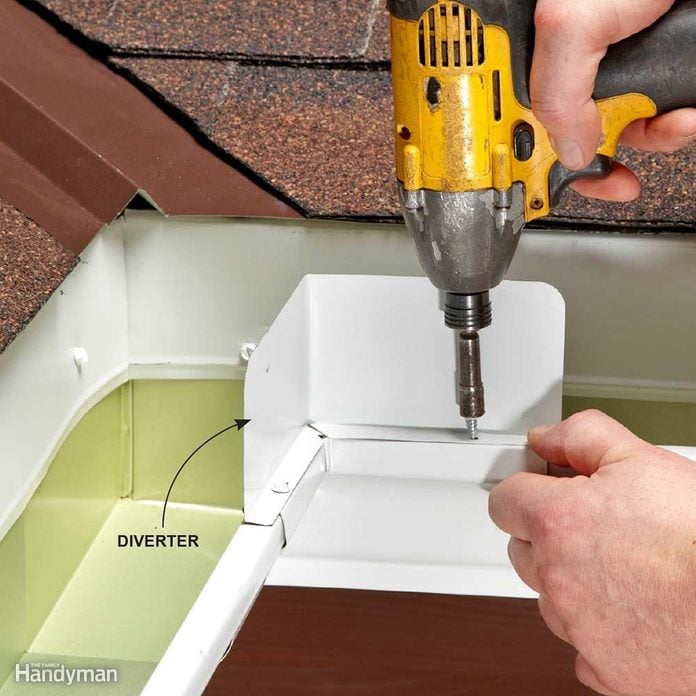
Leaking Gutters: What to do When Water Spills Over Gutter
Some roofs have long sections of valley that carry a lot of rainwater at high velocity. When that water comes blasting out the end of the valley, it can shoot right over the gutter. A diverter will help direct the water back into the gutter where it belongs. Fasten a diverter with a couple of sheet metal screws to the top of the outside edge of the gutter.
Read more.
7 / 14
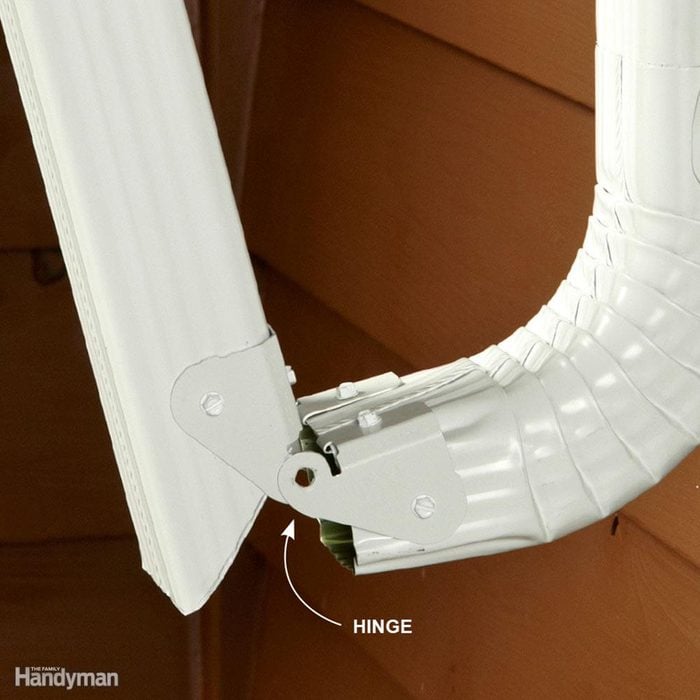
Downspout in the Way
Are you tired of removing your downspouts every time you mow? Consider installing a hinge where the lowest elbow meets the section of downspout that runs into your yard.
Installation is simple: Just cut the downspout at a 45-degree angle with a tin snips or metal-cutting blade and fasten the two-piece Zip Hinge (sold at home centers or online) with eight sheet metal screws. The hinges come in white only, so you might have to spray-paint them to match.
8 / 14
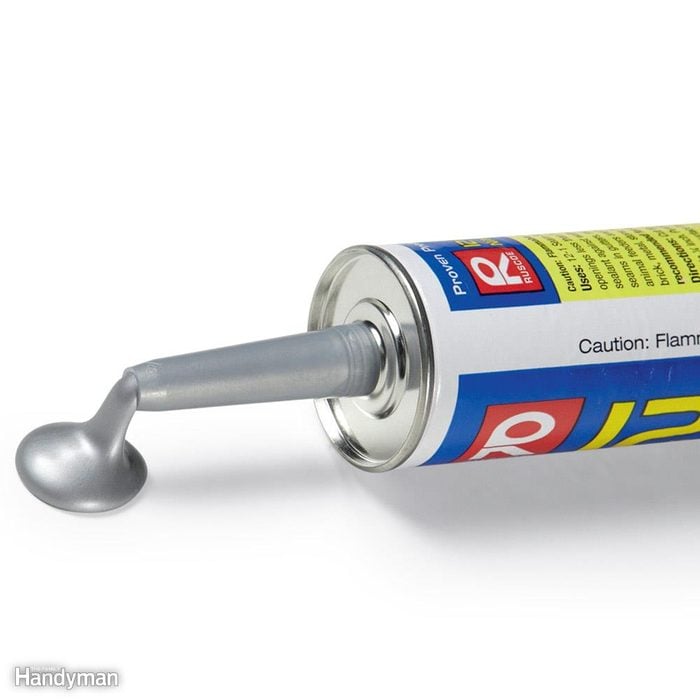
Leaky Gutters
Every connection on a metal gutter needs to be sealed: end caps, splices, drop outlets and miters. Buy a product that's specifically formulated to seal gutter seams. Seam sealer can handle submersion for long periods of time. It's also resistant to light, which it will get plenty of.
Most important, high-quality seam sealer is runny, so it can penetrate down into the seam for a durable, long-lasting connection. Most products refer to this property as "self-leveling." And the runnier the better, so if you're applying it on a cold day, keep the seam sealer somewhere warm so it stays fluid.
Try to remove as much of the old sealer as you can, and make sure the area you're sealing is completely dry. Home centers usually stock seam sealer near the gutter parts.
9 / 14
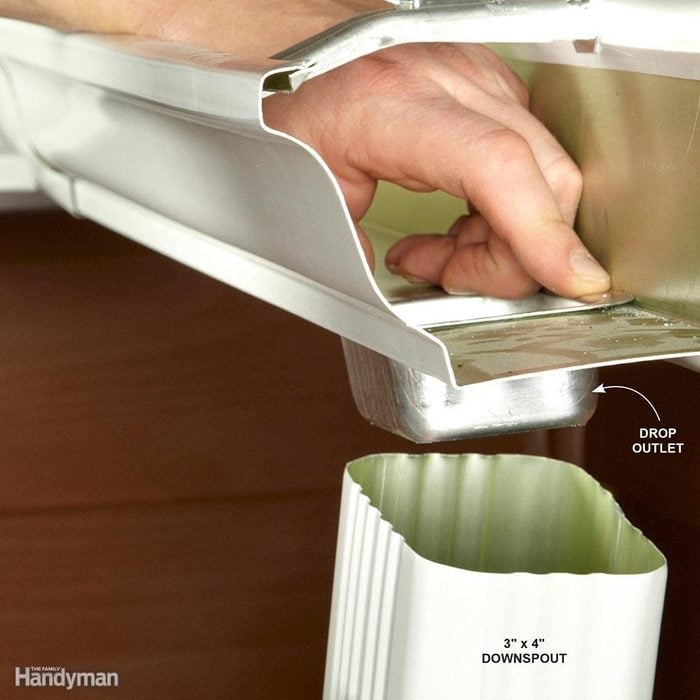
Gutters Overflow
If you have a 50-ft. gutter with one 2 x 3-in. downspout, your gutter probably overflows during heavier rainfalls. When installing an additional downspout isn't an option, install a 3 x 4-in. downspout in place of the smaller one.
Start by removing the old downspout. Use the new 3 x 4-in. drop outlet that you buy with your new downspout as a template to trace an outline for the larger hole. You can cut out the larger hole with a tin snips, or you could use an oscillating multi-tool equipped with a metal-cutting blade. Insert the drop outlet in the hole and fasten the new downspout with sheet metal screws. Make sure to seal the drop outlet to the gutter with seam sealer.
One downspout, one drop outlet, three elbows and two wall clips will cost about $40 at a home center. If you need a color other than white or brown, it will be a special order, but you should be able to get the color you need.
10 / 14

Sidewalk in the Way
There is no perfect way to get water from one side of a sidewalk to the other, but consider installing a retractable downspout. It rolls out when it rains and then rolls back up when the water stops flowing. Products like these do leak when the water flow is too light to extend the plastic downspout, but they should keep your landscaping from washing away during moderate to heavy rains.
Retractable downspouts are super easy to hook up, and they might be just the solution you're looking for. Pick one up at a home center or order online.
11 / 14
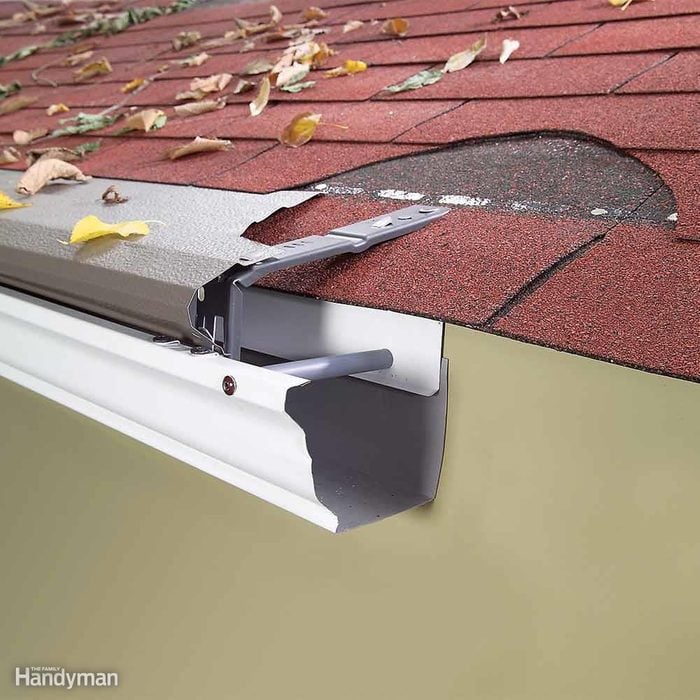
Gutter Guards Work
If you have trouble keeping small leaves and other debris from clogging your gutters, consider installing solid gutter guards. Solid guards, which cover all of the gutter except for a narrow crack to let the water through, do work well. The lip on the guards relies on surface tension to draw the water down into the gutter, while the solid covering deflects leaves and other debris that would otherwise drop in. The guards work on every type of gutter, except plastic "C" shapes. Since the guards fit over the gutter rather than inside, they'll cover most standard-size gutters. They're typically attached to the gutter with brackets, with the upper edge slid under the lower shingles. Screened gutter guards, which are much less expensive and available at home centers, don't work as well. They'll keep out most leaves, but you can expect smaller debris, such as seeds and pine needles, to get through. Screens also make gutter cleaning more difficult, because you have to move them aside to get at the debris. However, in some cases they may be all you need.
12 / 14

Gutter Cleaner
An old plastic spatula makes a great tool for cleaning debris from gutters! It doesn't scratch up the gutter, and you can cut it to fit gutter contours with snips. Grime wipes right off the spatula too, making cleanup a breeze. Don't feel like putting in that much elbow grease? Consider a gutter cleaning robot!
13 / 14
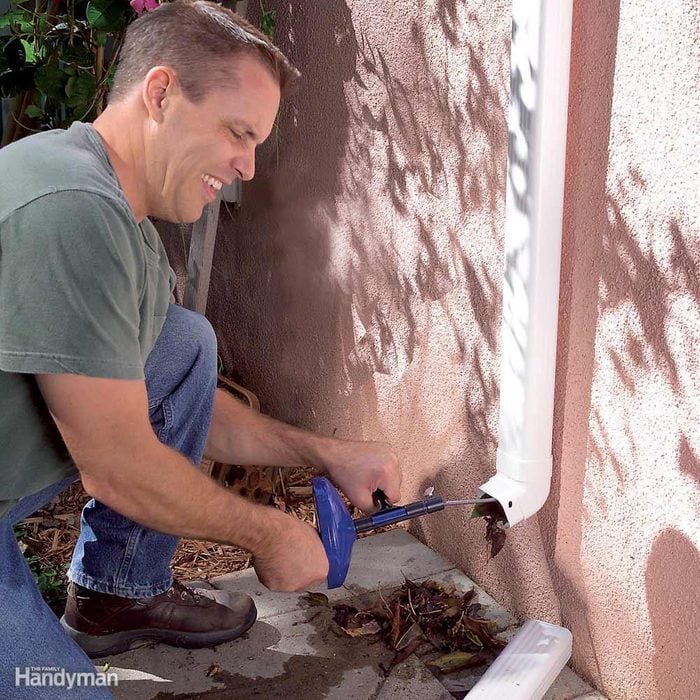
Gutter Spouts
This is an ongoing fall chore that you shouldn't overlook — clean all those wet autumn leaves from gutter spouts before the blockages damage your gutters. Your plumber's snake is a great tool for pulling clumps of wet leaves out of clogged downspouts. Check out more gutter-cleaning tips here.
14 / 14
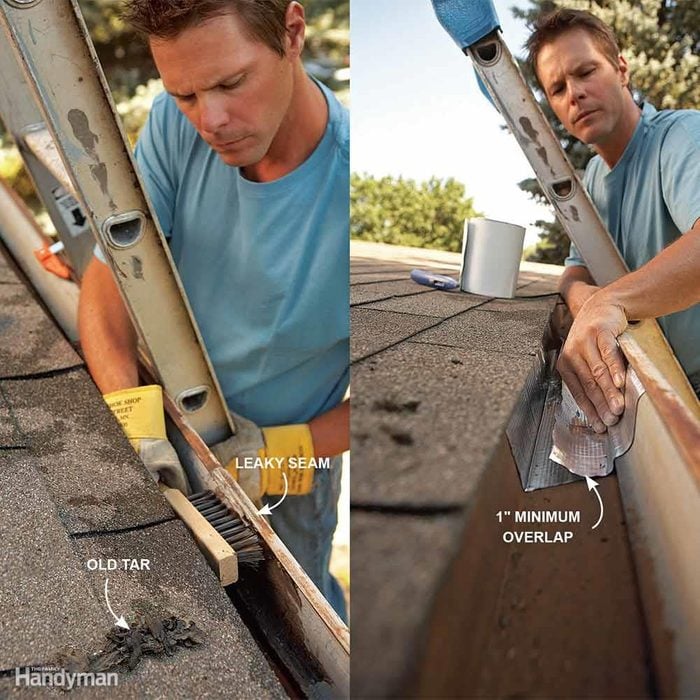
Rusting Metal Gutters
Gutter leaks usually start at rusty spots or seams that have opened up because of expansion and contraction. If your gutter is still basically sound, the easiest way to stop the leak is by covering the damaged area with roof and gutter repair tape (available at home centers and hardware stores).
Prepare the gutter by scraping out as much old tar or caulk as possible. Wire-brush the metal thoroughly to get rid of rust and to give the tape a clean surface for bonding (Photo 1). If the gutter is badly rusted or has been heavily coated with tar that you can't scrape out, spray on a special adhesive primer before applying the tape (Protecto-Tek is one brand, but you may need to special-order it).
Cut the tape with a scissors or a razor knife (Photo 2). Tear the paper backing off the tape and lightly adhere one edge of the tape to the top of the gutter. Roll the tape down the wall of the gutter, pushing it firmly into curves and corners (Photo 3). Work wrinkles and bubbles flat. Overlap long seams by at least 1 in. and end seams by 4 in.
Originally Published: November 29, 2019
sullivanfradenurry80.blogspot.com
Source: https://www.familyhandyman.com/list/easy-gutter-fixes/
0 Response to "How to Replace Continuous Corner Gutter"
Post a Comment